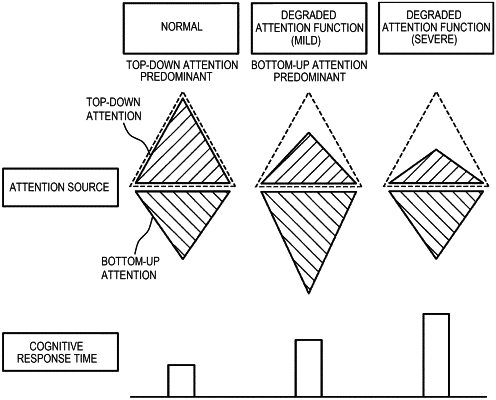| CPC G06F 3/013 (2013.01) [A61B 5/162 (2013.01); A61B 5/163 (2017.08); A61B 5/6898 (2013.01); G06F 3/0481 (2013.01); G06V 20/10 (2022.01); G06V 40/18 (2022.01); A61B 5/0022 (2013.01); A61B 5/0077 (2013.01); A61B 5/7435 (2013.01); A61B 5/7475 (2013.01); G06V 2201/02 (2022.01)] | 14 Claims |

|
1. A device that estimates a state of a user of a mobile terminal having a display for displaying an image, the state estimation device comprising
a sightline detector that detects a sightline of the user; and
processing circuitry configured to:
determine a top-down index value based on the image displayed on the display and the sightline of the user detected by the sightline detector, the top-down index value being correlated with an attention source amount that is allocated to top-down attention of the user with respect to the image on the display;
determine a bottom-up index value based on the image displayed on the display and the sightline of the user detected by the sightline detection, the bottom-up index value being correlated with the attention source amount that is allocated to bottom-up attention of the user with respect to the image on the display; and
estimate the state of the user including an attention function degraded state based on the top-down index value and the bottom-up index value, wherein
on condition that the top-down index value falls below a predetermined top-down threshold, the processing circuitry is configured to:
estimate that the user is in a first attention function degraded state when the bottom-up index value does not fall below a predetermined bottom-up threshold, and
estimate that the user is in a second attention function degraded state, in which an attention function is degraded in comparison with that in the first attention function degraded state, when the bottom-up index value falls below the bottom-up threshold.
|